MEET THE MINIS - MINIBRUTE vs MINITAUR
Posted on Thu 05 July 2012 in entries
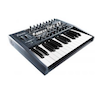 We sent out our avid gear hounds to track down two of the newest (and smallest) synths: the Moog Minitaur and Arturia MiniBrute...
We sent out our avid gear hounds to track down two of the newest (and smallest) synths: the Moog Minitaur and Arturia MiniBrute...
Any gear junkie worth his or her salt will keep a keen eye on the new products announced at the biggest annual music exhibitions. And at January’s Winter NAMM Show and Frankfurt Musikmesse in March, we were bemused to find that this year’s synth releases with the biggest impact actually had the tiniest footprint: the fiercely bassy Minitaur from synth legends Moog and the truly mind-warping MiniBrute from French boffins Arturia.
Who doesn’t love Moog? Nigh-on 60 years of analogue heritage and a roll-call of classic, sought-after machines, so when Moog releases a brand new synth, the world sits up and takes note. But wait, Arturia? Yep, that’s right, the gurus of virtual synth modelling have released an analogue synth. And what’s more surprising than that simple fact is just quite how unique a machine the MiniBrute is.
So should you get one and not the other? Well, as there are fundamental differences between the two, they’ll both appeal to different crowds and you may end up wanting both. So let’s take a closer look…
MINITAUR'S NO MYTH
Firstly, let’s take a look at the Moog Minitaur which comes hot on the heels of Moog’s last offering, the Taurus III. This was a pedal-based analogue synth inspired by the circuitry in Moog’s classic Taurus I, an unusual and extremely rare synth first seen in the 70s, that was all about the bass. The most flare-flapping, gnarly, booming subs with a ripping snarl on the mid-range. Anyone who’s heard the Taurus I or the limited edition Taurus III knows that sound for sure.
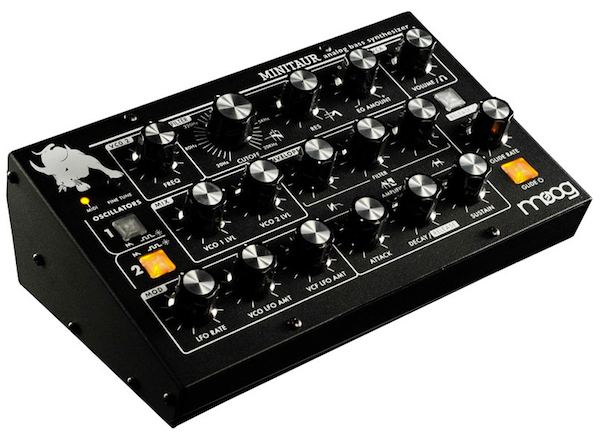 ](https://www.absolutemusic.co.uk/moog-minitaur-analogue-bass-synth-module.html)
](https://www.absolutemusic.co.uk/moog-minitaur-analogue-bass-synth-module.html)
Design-wise, the Taurus has a different filter and oscillator topology from the MiniMoogs and Phatties, and the new Minitaur sees Moog squeeze that flare-flapping sound into a tiny (8.5 x 5.25”) box but with a crazy £499 price tag that’s the other end of the spectrum from Taurus III’s £2,099 RRP, making it the most affordable Moog synth ever made. Interested? Thought so!
MINI IS MAXI
The Minitaur is a compact little desktop unit packed full of potentiometers. Take a careful look at the front panel and you’ll note that it has no less than two of the Taurus’s earth-shaking dual oscillators (switchable between square and triangle shapes using the light-up buttons) and dedicated mix controls let you dial in a blend of each.
VCO2 has a frequency control, so you can lock them in sync (and they stay very stably locked) or sweep the control and you’ll hear the oscillators start to beat against each other.
Right there at the top is the Taurus filter, a squelchy, satisfying and ever-so-slightly-overdriven warm filter. It’s a version of the Moog Ladder, but not the exact same filter design as in the Slim Phatty and Voyagers. An audio input means you can use that filter to wreak super warm havoc on any source material you have lying around.
TAKE TOTAL CONTROL
The Minitaur is strictly one knob-per-function, so there are no screens or menus. You just tweak it and get your sound. Interestingly there is a microchip in there that lets you send MIDI Control-Change messages (CCs) to the Minitaur, so it can be programmed/automated from your computer, DAW or any other MIDI kit that can send those messages.
 ](https://www.absolutemusic.co.uk/moog-minitaur-analogue-bass-synth-module.html)
](https://www.absolutemusic.co.uk/moog-minitaur-analogue-bass-synth-module.html)
It also sports a USB socket, a MIDI In and, appropriately, a complement of analogue Control Voltage inputs (Pitch, Filter, Volume, Gate) so you can connect it to any control voltage- enabled analogue synths you have. It’ll work perfectly alongside the Moog Slim Phatty, for instance, or the control voltage ‘toolkit’ that is the Moog CP-251, which adds an extra analogue LFO plus a host of Control Voltage warping tools.
There are also dual MiniMoog-style ADRs, an LFO, which can affect VCO, and a VCF (with dedicated controls for each).
MINITAUR IN A NUTSHELL
To sum it up, Minitaur is a simple yet formidable bass synth. Like some of the best synths, due to its simplicity, every sound it makes is utterly usable. You may wish for traditional preset storage, which it doesn’t have. But while there are no menus on Minitaur, it does respond to CCs, so you can send patches to it from other devices. The other key limitation is in the name: analogue bass synth. Like the Taurus III, the highest note it can play is middle C. So a true bass synth, and what sweet bass it is.
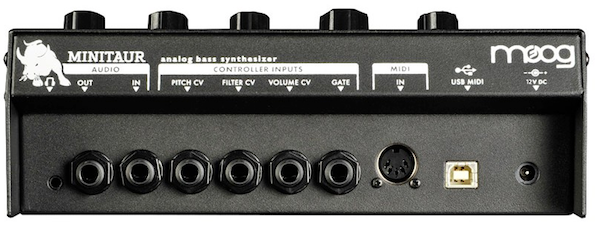 ](https://www.absolutemusic.co.uk/moog-minitaur-analogue-bass-synth-module.html)
](https://www.absolutemusic.co.uk/moog-minitaur-analogue-bass-synth-module.html)
ENTER ARTURIA
Arturia has a long heritage in designing recreations of classic analogue synths as software plug-ins. Indeed its first product was a recreation of the behemoth spaghetti junction that was the Moog Modular, officially endorsed by none other than Bob Moog himself.
Later came the hardware DSP modular wonderland that is Origin, which let you take virtual bits and bobs from classic synths and patch them together to create hybrids that could never exist: the oscillators from an ARP2600 married with the filter from a Jupiter 8, for example. Most recently Arturia released the Spark, a hands-on hybrid drum machine. It’s a disparate trio of products but they all have a reliance on software at their heart.
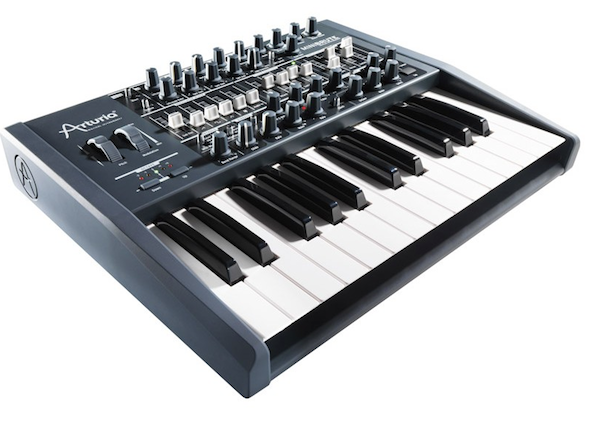 ](https://www.absolutemusic.co.uk/arturia-minibrute-analogue-monophonic-synthesizer.html)
](https://www.absolutemusic.co.uk/arturia-minibrute-analogue-monophonic-synthesizer.html)
IT'S WELL HARD
MiniBrute is a hardware synth whose entire audio path is 100% analogue. There are some digital parts to allow it to do things no vintage synth could do but, in terms of audio, there is no maths behind the scenes.
How is it done? Well, Arturia hired synth guru Yves Usson, a man who runs a synth-DIY resource site called YUsynth, a man who has owned, modified and built analogue synths from over 30 years. Who better to consult for a company looking to take a fresh approach to modern analogue synth design?
BIG BRUTE
Like the Minitaur, MiniBrute is a monophonic analogue synth with its roots in classics of the past. Unlike Minitaur, it has only one VCO but it’s an extremely complex one with five sources plus an audio input, so you can blend external audio in with the oscillators. You can even blend in raw waveforms from other synths (or computer) to turn MiniBrute into a multi-oscillator system.
The five sources are saw, square and triangle wave, sub oscillator (selectable saw or square), and a noise generator. The killer feature, however, is that each of the three primary waveforms has shaping controls. While you may be used to pulsewidth (available on the square wave), have you heard of ‘Ultrasaw’ and ‘Metalizer’? Here is where Usson’s influence is felt, as these are circuits of his own design.
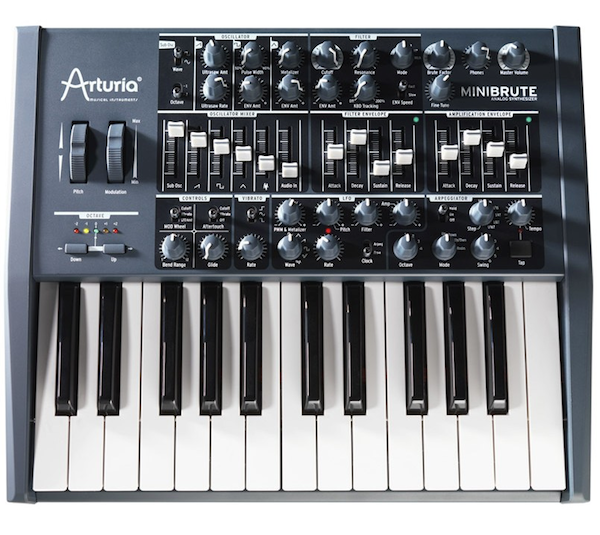 ](https://www.absolutemusic.co.uk/arturia-minibrute-analogue-monophonic-synthesizer.html)
](https://www.absolutemusic.co.uk/arturia-minibrute-analogue-monophonic-synthesizer.html)
MAKING WAVES
Ultrasaw creates phase-shifted copies of the primary saw wave and lets you control how they drift away from each other with the dedicated control and ‘Rate’ LFO. It sounds like you have several oscillators all beating together at once!
Metalizer is where things really depart from the norm. Metalizer is a form of wavefolder, which is rather like the opposite of a filter. Whereas a filter takes complex shapes and rolls the detail off them, a wavefolder takes a simple tone and bends it back on itself to make it more complex.
It sounds quite a lot like FM synthesis, with a scintillating, fizzy, buzzy tonality. Start wavefolding bass notes and you’ll end up with some truly strange, visceral sounds. The Metalizer control can be modulated by the Filter Envelope as well as by LFO, so it’s possible to create startling sounds that brighten, twist and fold over time.
Under all of these sits the sub oscillator, switchable between saw and square waves, and -1 or -2 octaves below the currently playing note. A little sub osc blended in suddenly gives a a glittering low end; it fattens it up beautifully.
All these various oscillator stages can be blended simultaneously, so calling this is a ‘one-oscillator’ synth is somewhat misleading!
FILTER FACTORY
The collection of oscillators gets run into the filter and for the MiniBrute, Arturia and Usson have come up with something awesome here. Back in the 70s, synth boffins Nyle Steiner and Dick Parker teamed up to produce various modular synths and a fixed-architecture machine: the legendary Synthacon. This rare three-oscillator beast was impressive in large part due to Steiner’s filter, a simple, elegant but extraordinary- sounding multi-mode filter. Warm yet cutting, capable of self-resonating, the filter was inspired and, most amazingly, increasing the resonance did not cause the bass levels to drop.
This very filter resides in the MiniBrute, with permission and consultation from Steiner himself. It’s the first time this filter has been heard since Synthacon.
BRUTAL FEEDBACK
Another trick up Arturia’s sleeve is Brute Factor. This is similar to what you get on a MiniMoog by running the headphone out back into the audio in, creating a feedback loop. On the MiniBrute, it is built in and the feedback loop is pre-filter (so you can filter the results), and at low settings gives a warming colour to the synth. Turn the dial to the max and the synth goes crazy, outputting strange and wild timbres. It will produce sound at high settings even with no oscillators blended in at all! You can also run external audio through the circuit.
 ](https://www.absolutemusic.co.uk/arturia-minibrute-analogue-monophonic-synthesizer.html)
](https://www.absolutemusic.co.uk/arturia-minibrute-analogue-monophonic-synthesizer.html)
MODULATION MOMENTS
Modulation wise, there are two LFOs: one with a host of different waveshapes (plus an arpeggiator with Tap Tempo) and a second to control vibrato with three different shapes. The primary LFO is digital, allowing it to sync to MIDI and to the arpeggiator, something never possible on vintage machines.
The LFO can be routed off to a host of different destinations, and there are two full ADSRs, both for Filter and Envelope, with a Range switch to take them from ultra-fast responses to slow, allowing for long drones to occur.
MiniBrute can’t send or respond to CC values, but it will send and receive CV. In fact it’ll act as a MIDI/USB to CV converter, so you can use MiniBrute to control any analogue synths you have that respond to CV.
All in all, MiniBrute is a stunning collection of controls (many of which we haven’t had room to mention) in a compact box. The build quality, like Minitaur’s, is fantastic: solid and chunky. Even better, MiniBrute will set you back a far from chunky £429 (price correct as of June 2012).
HOW TO CHOOSE?
Both MiniBrute and Minitaur feature unique abilities and traits. Minitaur is dual-oscillator, rich in tone, unbelievable for shaking woofers and can be programmed/automated with CCs. It’s a simple synth, but for bass it’s unstoppable in every situation. To top it off, it emerges as absolutely the most affordable way to have a genuine Moog Taurus in your studio.
MiniBrute is a wild, unpredictable outsider. While billed as a one-oscillator synth, it’s startlingly complex in design. Comprising a 25-note keyboard and a host of connections, it’ll open up a rabbit warren of experimentation, all with that wonderfully unique, raw, squealing gritty character. A totally different character to the Moog and slightly more affordable too.
But before you tick one box or t’other and reach for your wallet, let’s ponder something for a moment…
Run the MiniBrute’s CV outs into the Minitaur’s CV inputs, hook the Minitaur output into the MiniBrute input et voilà: a squealing, wild, three-oscillator bass-shaking monster with keyboard, aftertouch, vast modulation possibilities, and all for a pile less than a grand? Or run a stonking bassline from the Moog, while playing the wildest, chewy and strange MiniBrute solos over the top of it? Yep, you guessed it. I’m going to be getting both!
MINITAUR SPECS
• Price: £499
• Oscillators: Two
• Wave shapes: Sawtooth and square per VCO
• VCAs: Two mixer VCAs
• Filters: Moog Ladder filter with adjustable resonance
• Envelopes Generators: 2 ADSR for modulating VCF and VCA
• LFO: MIDI-syncable
• Ins & outs: MIDI DIN input, MIDI USB, 1/4” audio out, 1/4” audio in, Analog CV inputs (Pitch, Filter, Volume, Gate), headphones
MINIBRUTE SPECS
• Price: £429
• Oscillators: One VCO with sub-osc
• Signal enhancers: Pulsewidth modulation, Ultrasaw, Metalizer
• Envelope generators: Two ADSR with selectable slow/fast speed
• LFOs: Two
• Filter: Steiner-Parker two-pole multi-mode filter (low-pass, band-pass, high-pass, notch)
• Keyboard: 25 full-size semi-weighted keys with aftertouch
• Arpeggiator: Yes
• Ins & outs: Audio in, 1/4” audio out, Analog CV in/outputs (Pitch, Filter Amp), CV Gate selector (Audio, Hold, Keyboard) MIDI In/Out, MIDI USB In/Out, headphones
MORE INFO
For more information on either the Moog Minitaur or Arturia MiniBrute, click the links below or give us a call on 01202 597180.
Arturia MiniBrute - More Info/Buy
******If you're interested in buying and you have seen it cheaper elsewhere, please call us or use our
As well as receiving our first rate customer service you can also claim money off your next purchase with our loyalty points scheme and receive a 3 year warranty if you sign up to our FREE VIP Club (click here for more infomation). Many of our items also come out on a FREE next-day delivery service to mainland UK customers, so you won't be left waiting!
Also, if you want to keep up with all our latest offers, competitions, news and videos, why not follow us on Facebook and Twitter?

